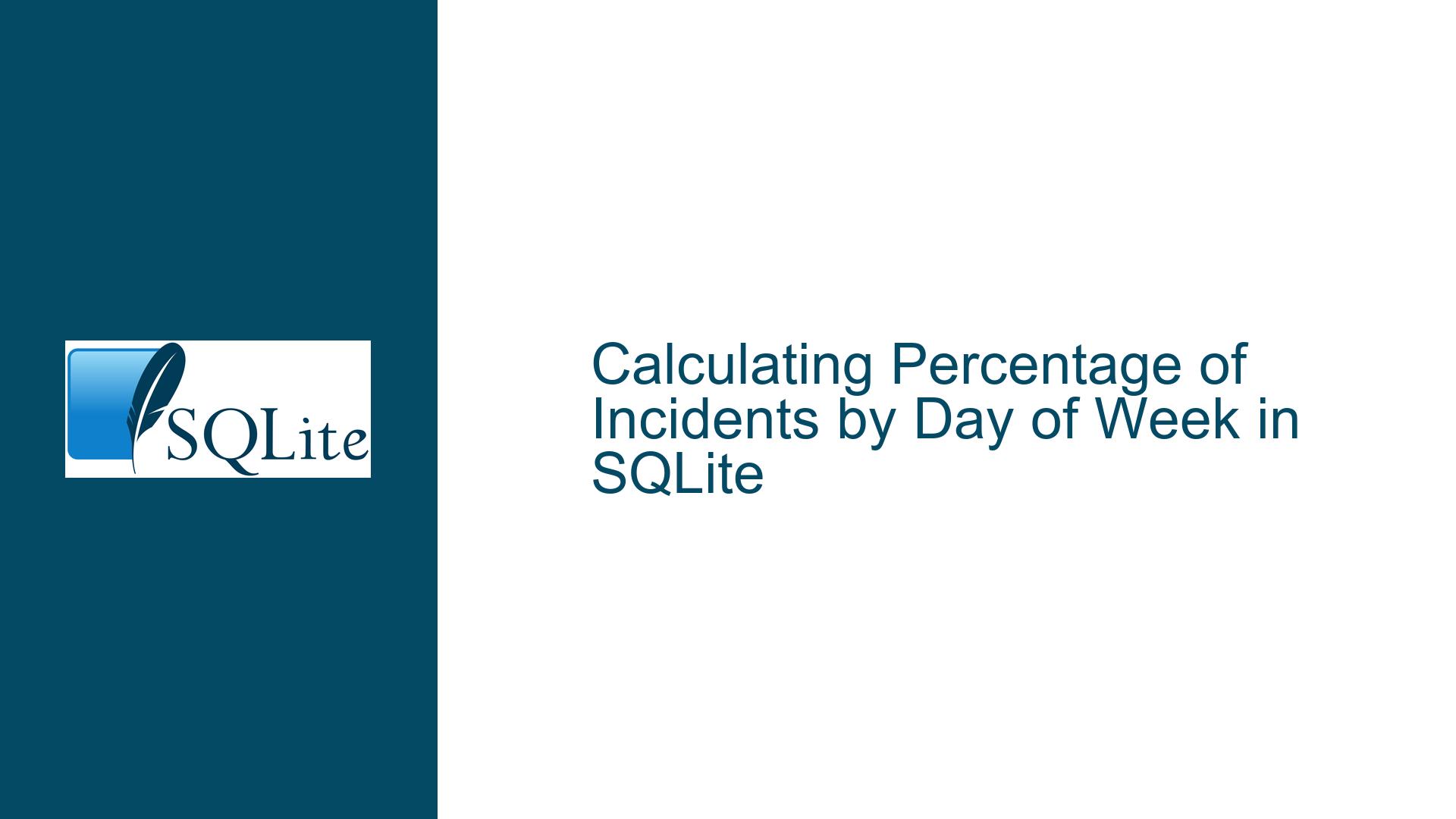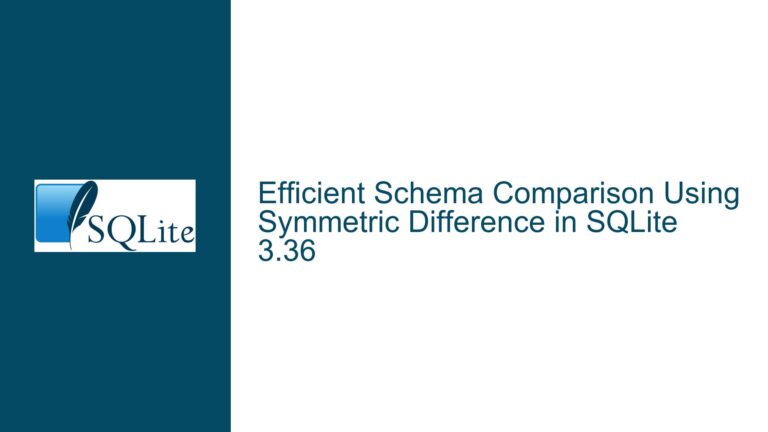Calculating Percentage of Incidents by Day of Week in SQLite
Issue Overview: Calculating Percentages of Incidents by Day of Week
The core issue revolves around calculating the percentage of incidents that occur on each day of the week (DoW) from a given dataset. The dataset contains traffic incident data, including an EventID, EventDate, EventTime, EventCode, EventDescription, and EventAddress. The goal is to determine the proportion of incidents that happen on each day of the week (Sunday through Saturday) within a specified date range. The initial query provided counts the incidents per day of the week but does not calculate the percentage of total incidents that each day represents.
The schema for the trafficdata table is straightforward, with EventID as the primary key and EventDate stored as a TEXT type. The query uses SQLite’s strftime function to extract the day of the week from the EventDate and groups the results by the day of the week. However, the query lacks the logic to calculate the percentage of incidents for each day relative to the total number of incidents in the specified date range.
The sample data provided includes ten records, each representing a traffic incident with a specific date, time, and event code. The initial query results show the count of incidents per day of the week but do not include the percentage calculation. The challenge is to modify the query to include this percentage calculation while maintaining the existing functionality.
Possible Causes: Why the Percentage Calculation is Missing
The absence of the percentage calculation in the initial query can be attributed to several factors. First, the query focuses solely on counting incidents per day of the week using the count(EventCode) function and grouping the results by the day of the week. While this provides a count of incidents per day, it does not account for the total number of incidents across all days, which is necessary for calculating percentages.
Second, the query does not utilize SQLite’s window functions, which are essential for performing calculations across rows without collapsing the result set into a single row. Window functions allow for the calculation of aggregate values (such as sums) while retaining the individual row context, making them ideal for percentage calculations.
Third, the initial query does not include the logic to divide the count of incidents per day by the total count of incidents and multiply by 100 to obtain the percentage. This step is crucial for transforming the raw counts into meaningful percentages that represent the proportion of incidents occurring on each day of the week.
Finally, the query’s structure does not account for potential edge cases, such as days with zero incidents. While the sample data provided does not include such cases, it is essential to ensure that the query can handle them gracefully to avoid division by zero errors or misleading results.
Troubleshooting Steps, Solutions & Fixes: Implementing Percentage Calculation
To address the issue and implement the percentage calculation, we need to modify the query to include the necessary logic. The following steps outline the process:
Step 1: Calculate the Total Number of Incidents
The first step is to calculate the total number of incidents within the specified date range. This value will serve as the denominator in the percentage calculation. We can achieve this by using a subquery or a window function. For simplicity and efficiency, we will use a window function.
The window function sum(count(EventCode)) over () calculates the sum of the count(EventCode) values across all rows, effectively providing the total number of incidents. This value is then used in the percentage calculation.
Step 2: Modify the Query to Include Percentage Calculation
Next, we modify the query to include the percentage calculation. The percentage for each day of the week is calculated by dividing the count of incidents for that day by the total number of incidents and multiplying by 100. We use the cast function to ensure that the division is performed using real numbers, avoiding integer division issues.
The modified query is as follows:
select
count(EventCode) as Incidents,
substr('SunMonTueWedThuFriSat', 1 + 3*strftime('%w', EventDate), 3) as DoW,
100 * cast(count(EventCode) AS REAL) / sum(count(EventCode)) over () as Percent
from
trafficdata
where
EventDate between ('2021-04-10') and ('2021-04-19')
and EventCode in ('401','401A','401B','401C')
group by
DoW
order by
Incidents desc;
In this query, the Percent column is calculated by multiplying the count of incidents for each day by 100 and dividing by the total number of incidents. The sum(count(EventCode)) over () window function provides the total number of incidents, ensuring that the percentage calculation is accurate.
Step 3: Handle Edge Cases
To ensure the query handles edge cases gracefully, we need to account for days with zero incidents. While the sample data does not include such cases, it is essential to ensure that the query does not produce errors or misleading results when encountering them.
One approach is to use a CASE statement to handle division by zero errors. However, in this specific scenario, the sum(count(EventCode)) over () function will always return a non-zero value if there is at least one incident in the specified date range. Therefore, additional handling is not strictly necessary for this query. However, if the dataset could potentially include date ranges with zero incidents, it would be prudent to add a check to ensure the total count is not zero before performing the division.
Step 4: Verify the Results
After modifying the query, it is essential to verify the results to ensure the percentage calculations are accurate. The expected output should include the count of incidents per day of the week and the corresponding percentage of total incidents.
For the provided sample data, the expected results are as follows:
Incidents,DoW,Percent
2,Sun,40.0
1,Thu,20.0
1,Sat,20.0
1,Mon,20.0
1,Fri,20.0
These results indicate that 40% of the incidents occurred on Sunday, while 20% occurred on Thursday, Saturday, Monday, and Friday. The percentages sum to 100%, confirming the accuracy of the calculation.
Step 5: Optimize the Query for Performance
While the modified query provides the desired results, it is essential to consider performance optimizations, especially for larger datasets. The use of window functions can be computationally expensive, so it is crucial to ensure that the query is as efficient as possible.
One optimization is to ensure that the EventDate column is indexed, as the query filters records based on this column. An index on EventDate will significantly speed up the filtering process, especially for large datasets.
Additionally, if the dataset includes a large number of event codes, it may be beneficial to create an index on the EventCode column to speed up the filtering process. However, for the provided sample data and query, these optimizations are not strictly necessary but should be considered for real-world applications.
Step 6: Consider Alternative Approaches
While the window function approach is efficient and concise, it is worth considering alternative approaches for calculating percentages in SQLite. One alternative is to use a subquery to calculate the total number of incidents and then join this value with the main query.
The following query demonstrates this approach:
with TotalIncidents as (
select count(EventCode) as Total
from trafficdata
where EventDate between ('2021-04-10') and ('2021-04-19')
and EventCode in ('401','401A','401B','401C')
)
select
count(t.EventCode) as Incidents,
substr('SunMonTueWedThuFriSat', 1 + 3*strftime('%w', t.EventDate), 3) as DoW,
100 * cast(count(t.EventCode) AS REAL) / ti.Total as Percent
from
trafficdata t, TotalIncidents ti
where
t.EventDate between ('2021-04-10') and ('2021-04-19')
and t.EventCode in ('401','401A','401B','401C')
group by
DoW
order by
Incidents desc;
In this query, the TotalIncidents common table expression (CTE) calculates the total number of incidents within the specified date range. This value is then joined with the main query to calculate the percentage of incidents per day of the week.
While this approach is more verbose, it may be more intuitive for some users and can be easier to debug and modify. However, it is generally less efficient than the window function approach, especially for large datasets.
Step 7: Finalize the Query and Document
Once the query has been optimized and verified, it is essential to document the final version for future reference. The documentation should include a description of the query’s purpose, the schema of the trafficdata table, and any assumptions or constraints (e.g., the date range and event codes used in the query).
Additionally, it is helpful to include comments within the query itself to explain the logic and any complex calculations. This documentation will ensure that the query can be easily understood and maintained by other developers or database administrators.
Conclusion
Calculating the percentage of incidents by day of the week in SQLite requires a combination of aggregate functions, window functions, and careful handling of edge cases. By following the steps outlined above, you can modify the initial query to include the necessary percentage calculation while maintaining accuracy and performance. Whether you choose to use window functions or subqueries, the key is to ensure that the query is both efficient and easy to understand, making it a valuable tool for analyzing traffic incident data.






